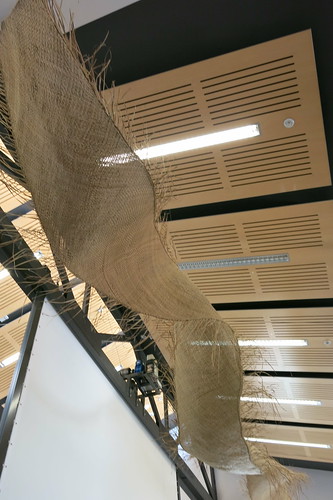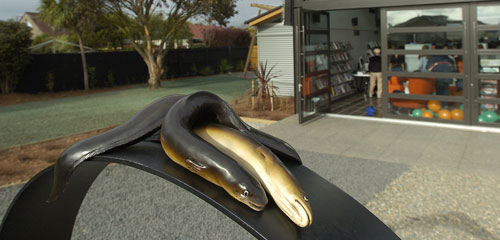Imagine you’re sitting on the banks of a river, book in hand, as shoals of eels swim past your feet. It’s a vision that Christchurch artist Bing Dawe created for Parklands Library, which opened in August 2005 in north-east Christchurch.
The aim was to develop a building to hold stories which itself told a story. The result was a series of unique artworks telling the story of the Parklands Waitikiri area before European settlement, offering a stunning backdrop and added interest for visitors to the library.
Eels sculpture and River carpet
Christchurch City Libraries commissioned local artist Bing Dawe to create a sculpture in the form of a large hoop with three eels on its top edge, placed on the library's rear terrace. Dawe also designed a carpet river of eels running through the building.
The sculpture and carpet evoke the wetlands which existed across the Parklands area before European settlement, teeming with wildlife including native birds, fish and eels. They were a major source of food for local Māori tribes. Nearby Travis Wetland is one of the few reminders of what the area once looked like. The artworks are also intended as a reminder that what goes into our waterways today affects our environment tomorrow, including the birds and fish which rely on our rivers and wetlands.
The river carpet was specially produced by local carpet specialist Custom Carpets NZ and was removed as part of post-quake repairs in 2019. It was replaced with a patterned carpet suggestive of the original river of eels design.
Whāriki Matariki

A third major artwork, the 'Whāriki Matariki', is a magnificent 8-metre flax weaving in the shape of an eel swimming overhead as customers enter the library. The whāriki was created by customers of eight Christchurch libraries over four weeks to mark the opening of the new library. Customers added to it at each library before it was presented to the library as a gift to the people of the Parklands area.
Matariki signals growth. It's a time of change, a time to prepare and a time of action. During Matariki we acknowledge what we have and what we have to give. Matariki celebrates the diversity of life. It's a celebration of culture, language, spirit and people. Matariki is our Aotearoa Pacific New Year.
The whāriki is the mat that lies underneath all, it is a foundation that protects, warms and nurtures. It is a traditional craft that fits well with in a modern environment and it is a perfect object to symbolise the beginning of the Māori New Year, Matariki.
Christchurch City Libraries celebrated Matariki 2005 by weaving a whāriki using harakeke (NZ flax). The weaving took place in eight Libraries around Christchurch during June. Simon Rutherford was in the Libraries on Tuesday and Wednesday each week, encouraging the public to work on the whāriki with him. The whāriki grew over the sessions to about 8 metres long and over half a metre wide.
Photographs of the weaving of the Whāriki Matariki.
The preparation for the whāriki
On Monday 6 June Library colleagues and friends gathered at the Janet Stewart Reserve, where a pā harakeke has been established for weavers. They cut and processed the harakeke into strips, then hapene (scrape to soften) and blanched them for drying for later use.
Simon arrived at each library with the whāriki and strips ready to use. He spent time at each library weaving himself and encouraging visitors to join him and weave a row.
Simon has been weaving for eight years since learning at the feet of Cath Brown, one of the key figures in raranga. He is almost always working on some project and has a regular group and also takes intermediate school classes for weaving experience sessions.
When the artworks were installed, the library’s art and design consultant, Mark McEntyre, said they would help to make the library an exciting space:
"They’re real, they’re accessible, people will be able to touch them and walk on them. As children play on the library floor, they’ll be playing in the river. While they’re reading their stories, we’ll also be sharing the story of the area with them through Bing’s work."
Learn about the Christchurch City Libraries' art collections


